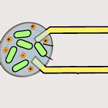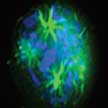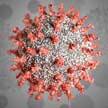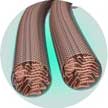Showing Spotlights 97 - 104 of 544 in category All (newest first):
 Vertical semiconductor nanowire arrays are a promising material for retinal prostheses, which could help restore the eyesight of people suffering from severe retinal diseases. These nanowires could also be used to fabricate bio-inspired photoreceptors and lightweight, highly efficient photovoltaics. In new work, scientists present theoretical and experimental studies on the microscopic optical behavior of highly dense and randomly distributed nanowire arrays embedded in a transparent polymer.
Vertical semiconductor nanowire arrays are a promising material for retinal prostheses, which could help restore the eyesight of people suffering from severe retinal diseases. These nanowires could also be used to fabricate bio-inspired photoreceptors and lightweight, highly efficient photovoltaics. In new work, scientists present theoretical and experimental studies on the microscopic optical behavior of highly dense and randomly distributed nanowire arrays embedded in a transparent polymer.
Jun 18th, 2020
 New research demonstrates the integration of synthetic biology with electronic circuitry through engineered population dynamics that regulate the accumulation of charged metabolites. The resulting sensor devices can detect changes in bacterial population in response to the presence of chemicals, light or pH. Connecting bacterial gene expression to electrodes is an appealing approach to interface genetic circuits with microelectronics for multiple applications. In this work, researchers engineered bacterial circuits capable of controlling the conductivity of the media via cell growth and death. Therefore, the electronic output is controlled by a killing gene.
New research demonstrates the integration of synthetic biology with electronic circuitry through engineered population dynamics that regulate the accumulation of charged metabolites. The resulting sensor devices can detect changes in bacterial population in response to the presence of chemicals, light or pH. Connecting bacterial gene expression to electrodes is an appealing approach to interface genetic circuits with microelectronics for multiple applications. In this work, researchers engineered bacterial circuits capable of controlling the conductivity of the media via cell growth and death. Therefore, the electronic output is controlled by a killing gene.
May 26th, 2020
 Miniaturized needle-like carriers in high aspect ratio structures are a novel class of implantable electronic devices. They are used to deliver tiny sensors and stimulation tools inside the body via minimally invasive injection or insertion into a specific area of an organ. A recent review summarizes the latest developments in materials, designs, and manufacturing techniques in the field of injectable biomedical devices, highlighting unique applications and demonstrations of viable clinical tools that were applied in various internal organs.
Miniaturized needle-like carriers in high aspect ratio structures are a novel class of implantable electronic devices. They are used to deliver tiny sensors and stimulation tools inside the body via minimally invasive injection or insertion into a specific area of an organ. A recent review summarizes the latest developments in materials, designs, and manufacturing techniques in the field of injectable biomedical devices, highlighting unique applications and demonstrations of viable clinical tools that were applied in various internal organs.
May 19th, 2020
 Hepatocellular carcinoma (HCC) is is the most common type of primary liver cancer and one of the most aggressive and hyper-vascularized forms of cancer. Many current chemotherapeutics fail to achieve the effective therapeutic index in the solid tumours due to poor drug penetration, poor bioavailability, non-specificity and drug resistance - a challenging aspect in this field. In search of new modalities, researchers have developed multifunctional polymeric nanoparticles against HCC. These biocompatible multifunctional polymeric nanoparticles hold trimodal affinity towards targeting microtubules, tyrosine kinases, and high-sensitivity imaging system quantum dots.
Hepatocellular carcinoma (HCC) is is the most common type of primary liver cancer and one of the most aggressive and hyper-vascularized forms of cancer. Many current chemotherapeutics fail to achieve the effective therapeutic index in the solid tumours due to poor drug penetration, poor bioavailability, non-specificity and drug resistance - a challenging aspect in this field. In search of new modalities, researchers have developed multifunctional polymeric nanoparticles against HCC. These biocompatible multifunctional polymeric nanoparticles hold trimodal affinity towards targeting microtubules, tyrosine kinases, and high-sensitivity imaging system quantum dots.
May 14th, 2020
 Breath is one of the main sources of human health parameters that can be used for predicting the state of internal organs. Exhaled breath composition is very complex and the existence of disease marker molecules can be as low as one part per million. That means that using breath for health monitoring purposes requires highly sensitive tools with a recognition ability down to single molecules. Researchers developed a method for fast, on-site and still accurate breath analysis that does not need special preparation of breath samples. The method is based on an electronic nose platform that uses a set of single-walled carbon nanotube sensors deposited on flexible substrates and modified by different semiconducting organic molecules.
Breath is one of the main sources of human health parameters that can be used for predicting the state of internal organs. Exhaled breath composition is very complex and the existence of disease marker molecules can be as low as one part per million. That means that using breath for health monitoring purposes requires highly sensitive tools with a recognition ability down to single molecules. Researchers developed a method for fast, on-site and still accurate breath analysis that does not need special preparation of breath samples. The method is based on an electronic nose platform that uses a set of single-walled carbon nanotube sensors deposited on flexible substrates and modified by different semiconducting organic molecules.
May 13th, 2020
 In the absence of vaccines, many scientists argue that the best approach to control the spread of the Severe Acute Respiratory Syndrome Virus 2 (SARS-CoV-2) would be fast, cheap, reliable, and portable means of diagnosing COVID-19 infection. In particular, the identification of patients with the highest risk of COVID-19 mortality (i.e. those with co-morbidities such as cardiovascular disorders or massive alveolar damage and progressive respiratory failure) could significantly improve the capacity of healthcare providers to take early action and minimize the possibility of overwhelming care centers, which in turn would save many lives.
In the absence of vaccines, many scientists argue that the best approach to control the spread of the Severe Acute Respiratory Syndrome Virus 2 (SARS-CoV-2) would be fast, cheap, reliable, and portable means of diagnosing COVID-19 infection. In particular, the identification of patients with the highest risk of COVID-19 mortality (i.e. those with co-morbidities such as cardiovascular disorders or massive alveolar damage and progressive respiratory failure) could significantly improve the capacity of healthcare providers to take early action and minimize the possibility of overwhelming care centers, which in turn would save many lives.
May 12th, 2020
 Researchers exploited for the first time cellular self-recognition process for targeting glioblastoma cells with boron nitride nanotubes (BNNTs), a biocompatible, yet inorganic, nanomaterial.
The team loaded the BNNTs with doxorubicin, a powerful chemotherapy drug, and then functionalized them with glioblastoma cell membranes This targeting approach benefits from the ability of cancer cells to recognize each other due to similarities present on their membrane that make them different from healthy cells.
Researchers exploited for the first time cellular self-recognition process for targeting glioblastoma cells with boron nitride nanotubes (BNNTs), a biocompatible, yet inorganic, nanomaterial.
The team loaded the BNNTs with doxorubicin, a powerful chemotherapy drug, and then functionalized them with glioblastoma cell membranes This targeting approach benefits from the ability of cancer cells to recognize each other due to similarities present on their membrane that make them different from healthy cells.
May 11th, 2020
 Deep brain stimulation (DBS) is an effective treatment for many neurological disorders, but despite its widespread utilization the underlying mechanisms and downstream effects of DBS remain poorly understood. One major issue to understand the therapeutic mechanism of DBS is to map the wide variety of brain responses at both the local and global levels. Researchers have developed a highly MRI-compatible graphene fiber electrode that enables full activation pattern mapping by functional magnetic resonance imaging under DBS without the occurence of artifacts resulting from magnetic field interference.
Deep brain stimulation (DBS) is an effective treatment for many neurological disorders, but despite its widespread utilization the underlying mechanisms and downstream effects of DBS remain poorly understood. One major issue to understand the therapeutic mechanism of DBS is to map the wide variety of brain responses at both the local and global levels. Researchers have developed a highly MRI-compatible graphene fiber electrode that enables full activation pattern mapping by functional magnetic resonance imaging under DBS without the occurence of artifacts resulting from magnetic field interference.
Apr 20th, 2020
 Vertical semiconductor nanowire arrays are a promising material for retinal prostheses, which could help restore the eyesight of people suffering from severe retinal diseases. These nanowires could also be used to fabricate bio-inspired photoreceptors and lightweight, highly efficient photovoltaics. In new work, scientists present theoretical and experimental studies on the microscopic optical behavior of highly dense and randomly distributed nanowire arrays embedded in a transparent polymer.
Vertical semiconductor nanowire arrays are a promising material for retinal prostheses, which could help restore the eyesight of people suffering from severe retinal diseases. These nanowires could also be used to fabricate bio-inspired photoreceptors and lightweight, highly efficient photovoltaics. In new work, scientists present theoretical and experimental studies on the microscopic optical behavior of highly dense and randomly distributed nanowire arrays embedded in a transparent polymer.
 Subscribe to our Nanotechnology Spotlight feed
Subscribe to our Nanotechnology Spotlight feed





